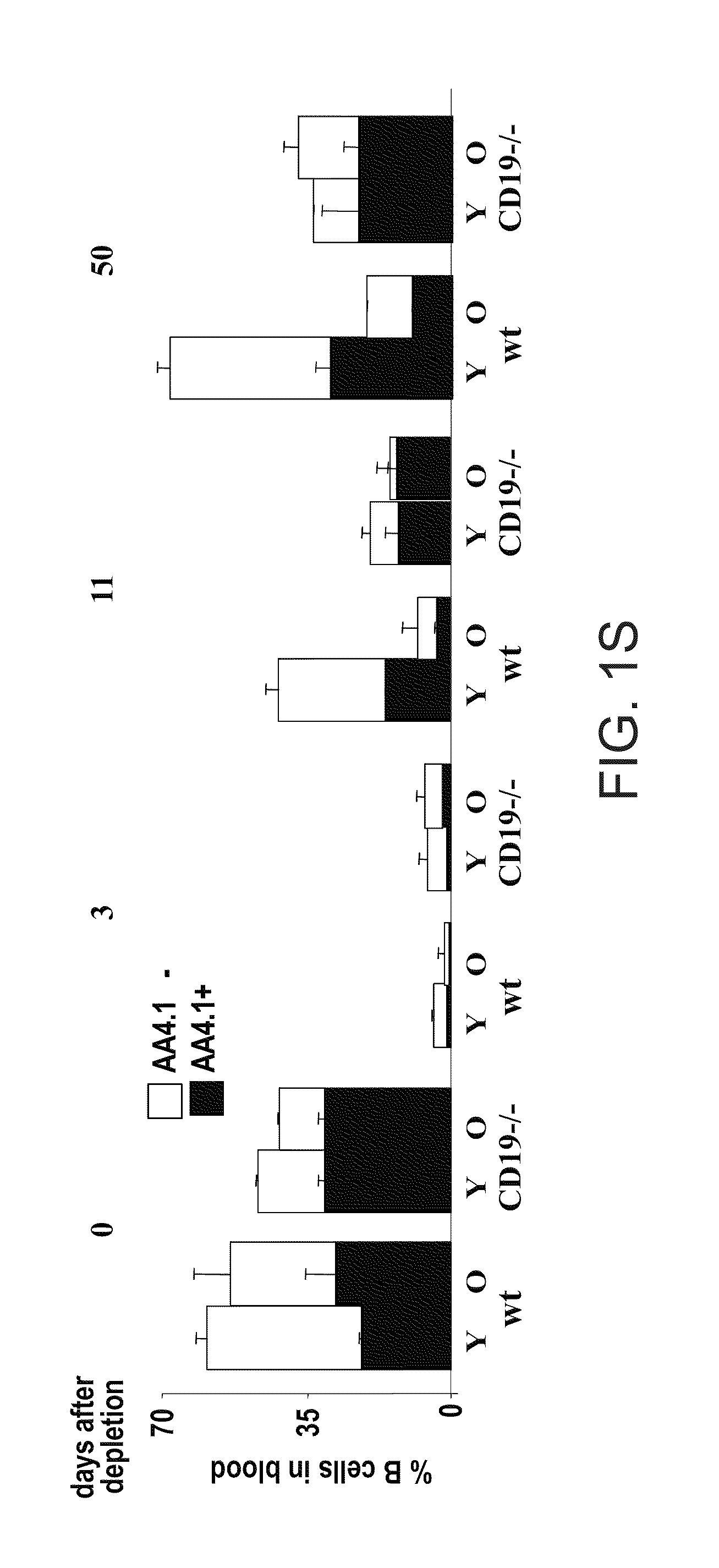Methods of altering peripheral b cell populations and uses thereof
a technology of peripheral b cells and b cell populations, applied in the direction of antibody medical ingredients, drug compositions, peptides, etc., can solve the problems of affecting the development of the immune system and its ability to function, affecting the morbidity and mortality of the elderly population, and a heightened susceptibility of the elderly population
- Summary
- Abstract
- Description
- Claims
- Application Information
AI Technical Summary
Benefits of technology
Problems solved by technology
Method used
Image
Examples
example 1
Chronic Homeostatic Demands Block Senescence in B Lymphopoiesis
[0201]To examine the mechanism by which the B lineage enters senescence, inventors used mice deficient in CD19 (CD19− / −) or invariant chain (Ii− / −). In these mouse models, B-cell development in the BM was almost unperturbed, but B-cell maturation and survival in the periphery was impaired owing in part to a defective T-cell response. Thus, these mouse lines had a chronic B-cell deficiency (reduced by 30-40%) in the periphery. Inventors hypothesized that if senescence of the B lineage was a progressive and not reversible process, then the CD19− / − and Ii− / − mice should gradually lose their peripheral B cells and become B-cell-less mice as they aged. If, however, senescence of the B lineage was due to homeostatic pressures from the long-lived peripheral B cells, then B lymphopoiesis in the CD19- or Ii-deficient mice, which lacked long-lived B cells, should not enter senescence.
[0202]As shown in FIGS. 1A-S, B lymphopoiesis i...
example 2
Peripheral Repertoire Does Not Age Upon Chronic Homeostatic Demands
[0205]Since the diversity of the peripheral B-cell repertoire is profoundly reduced with aging, inventors next tested whether the development of an age-dependent limited repertoire was prevented in mice deficient in CD19. Cambier and colleagues [Johnson, Rozzo and Cambier, J. Immunol. (2002) 168, 5014-5023] used an immunoglobulin transgenic (Ig-Tg) mouse model (3-83 Tg mice) to report age-associated changes in the B-cell repertoire. This peripheral repertoire changed with aging, and in old 3-83 Tg mice, it was dominated by B cells that expressed endogenous receptors. According to Russell et al. [Russell et al. Nature (1991) 354, 308-311], in young 3-83 Tg mice, about 90% of the splenic B cells expressed the transgenic receptor.
[0206]In sharp contrast, the inventors of the present invention found that the development of this old-like repertoire was prevented in 3-83 Tg mice that were deficient in CD19 (FIGS. 3A-F), in...
example 3
Limiting BAFF Signaling Stimulates Homeostatic Demands for B Cells and Prevents Senescence in the B Lineage
[0207]Since lack CD19 or Ii perturbs the normal function of the B cells, inventors decided to verify these observations under physiological conditions. To do so, inventors used mice homozygous for a targeted loxP-flanked BAFF-R allele (BAFF-Rf / f) and transgenic for cre-recombinase driven by the interferon promoter (Mx-cre). BAFF-BAFF-R signaling is an essential survival factor for mature B cells, but is dispensable for B lymphopoiesis in the BM. In these mice, administration of the interferon inducer poly(I)-poly(C) resulted in the ablation of BAFF-R (depletion efficiency in the spleen 80-90% as determined by EYFP-Cre-reporter system, FIGS. 4E-G), the depletion of about 50% of the B cells as measured in the peripheral blood and spleen, and the appearance of many newly generated B220+ / AA4.1+ B cells (FIGS. 4A-D). In old BAFF-Rf / f Mx-cre mice, the peripheral B-cell deficiency tha...
PUM
| Property | Measurement | Unit |
|---|---|---|
| Time | aaaaa | aaaaa |
Abstract
Description
Claims
Application Information
 Login to View More
Login to View More - R&D
- Intellectual Property
- Life Sciences
- Materials
- Tech Scout
- Unparalleled Data Quality
- Higher Quality Content
- 60% Fewer Hallucinations
Browse by: Latest US Patents, China's latest patents, Technical Efficacy Thesaurus, Application Domain, Technology Topic, Popular Technical Reports.
© 2025 PatSnap. All rights reserved.Legal|Privacy policy|Modern Slavery Act Transparency Statement|Sitemap|About US| Contact US: help@patsnap.com



